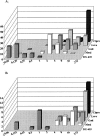Antistaphylococcal activity of DX-619, a new des-F(6)-quinolone, compared to those of other agents
- PMID: 16048943
- PMCID: PMC1196248
- DOI: 10.1128/AAC.49.8.3325-3333.2005
Antistaphylococcal activity of DX-619, a new des-F(6)-quinolone, compared to those of other agents
Abstract
The in vitro activity of DX-619, a new des-F(6)-quinolone, was tested against staphylococci and compared to those of other antimicrobials. DX-619 had the lowest MIC ranges/MIC(50)s/MIC(90)s (microg/ml) against 131 Staphylococcus aureus strains (</=0.002 to 2.0/0.06/0.5) and 128 coagulase-negative staphylococci (0.004 to 0.25/0.016/0.125). Among strains tested, 76 S. aureus strains and 51 coagulase-negative staphylococci were resistant to ciprofloxacin. DX-619 had the lowest MIC(50)/MIC(90) values against 127 quinolone-resistant staphylococci (0.125/0.5), followed by sitafloxacin (0.5/4), moxifloxacin (2/8), gatifloxacin (4/16), levofloxacin (16/>32), and ciprofloxacin (>32/>32). Raised quinolone MICs were associated with mutations in GyrA (S84L) and single or double mutations in GrlA (S80F or Y; E84K, G, or V) in all S. aureus strains tested. A recent vancomycin-resistant S. aureus (VRSA) strain (Hershey) was resistant to available quinolones and was inhibited by DX-619 at 0.25 microg/ml and sitafloxacin at 1.0 microg/ml. Vancomycin (except VRSA), linezolid, ranbezolid, tigecycline, and quinupristin-dalfopristin were active against all strains, and teicoplanin was active against S. aureus but less active against coagulase-negative staphylococci. DX-619 produced resistant mutants with MICs of 1 to >32 microg/ml after <50 days of selection compared to 16 to >32 microg/ml for ciprofloxacin, sitafloxacin, moxifloxacin, and gatifloxacin. DX-619 and sitafloxacin were also more active than other tested drugs against selected mutants and had the lowest mutation frequencies in single-step resistance selection. DX-619 and sitafloxacin were bactericidal against six quinolone-resistant (including the VRSA) and seven quinolone-susceptible strains tested, whereas gatifloxacin, moxifloxacin, levofloxacin, and ciprofloxacin were bactericidal against 11, 10, 7, and 5 strains at 4x MIC after 24 h, respectively. DX-619 was also bactericidal against one other VRSA strain, five vancomycin-intermediate S. aureus strains, and four vancomycin-intermediate coagulase-negative staphylococci. Linezolid, ranbezolid, and tigecycline were bacteriostatic and quinupristin-dalfopristin, teicoplanin, and vancomycin were bactericidal against two, eight, and nine strains, and daptomycin and oritavancin were rapidly bactericidal against all strains, including the VRSA. DX-619 has potent in vitro activity against staphylococci, including methicillin-, ciprofloxacin-, and vancomycin-resistant strains.
Figures



References
-
- Blumberg, H. M., D. Rimland, D. J. Carroll, P. Terry, and I. K. Wachsmuth. 1991. Rapid development of ciprofloxacin resistance in methicillin-susceptible and -resistant Staphylococcus aureus. J. Infect. Dis. 163:1279-1285. - PubMed
-
- Bozdogan, B., D. Esel, C. Whitener, F. A. Browne, and P. C. Appelbaum. 2003. Antibacterial susceptibility of a vancomycin-resistant Staphylococcus aureus strain isolated at the Hershey Medical Center. J. Antimicrob. Chemother. 52:864-868. - PubMed
-
- Cercenado, E., F. Garcia-Garrote, and E. Bouza. 2001. In-vitro activity of linezolid against multiply resistant Gram-positive clinical isolates. J. Antimicrob. Chemother. 47:77-81. - PubMed
-
- Cuny, C., and W. Witte. 2000. In vitro activity of linezolid against staphylococci. Clin. Microbiol. Infect. 6:328-333. - PubMed
Publication types
MeSH terms
Substances
LinkOut - more resources
Full Text Sources

